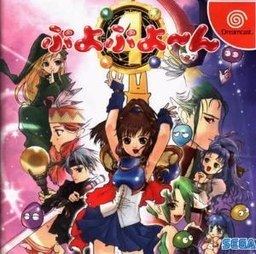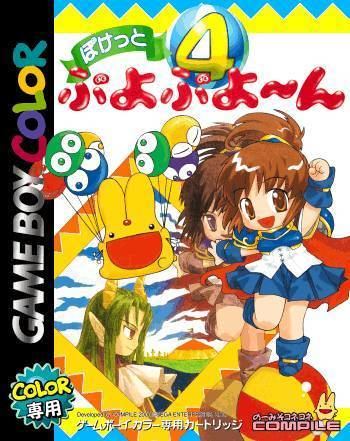9.4 /10 1 Votes9.4
Initial release date 4 March 1999 | 4.7/5 Emuparadise Genre Puzzle video game | |||||||||||||||||||||||||||||||||
Mode(s) Single player, multiplayer Similar Puyo Puyo games, Compile games, Puzzle video games | ||||||||||||||||||||||||||||||||||
Pocket puyo puyo n
Puyo Puyo~n (ぷよぷよ〜ん, Puyopuyōn), also known as Puyo Puyo 4, and Puyo Puyo~n Party (for the N64 version) is the fourth installment of the Puyo Puyo puzzle game series, created by Sega and Compile for the Sega Dreamcast, Sony PlayStation, Nintendo 64 and Game Boy Color. Like many of the Puyo Puyo games, it was never officially released outside Japan. The title of Puyo Puyo~n comes from the Japanese word yon (四, meaning four), signifying the fourth game in the series. Plans were made for a 64DD version entitled Puyo Puyo~n 64 (ぷよぷよ〜ん, Puyopuyōn rokujuon), but it was later cancelled.
Contents

Gameplay

The gameplay of ~n remains similar to Puyo Puyo Tsu, with a new addition of character specials. As puyos are erased from the field, a power gauge fills up, and as it fills to the top, you can use a special. Each characters special ability differs from person to person, and these specials are very different between the domestic versions and the Game Boy Color version. Each grid in the domestic versions follows Rule Henka, where a preset field and special board rules are implemented. In the Game Boy Color version, whenever garbage was countered, Sun puyos would fall on the screens. This game also featured a few Tokoton modes where you could play on grids larger or smaller than 6x12 on the domestic versions, and featured a Free Battle mode where you could play against any of the other unlocked characters. The art is also vastly different from its predecessors, adopting a more serious tone compared to the other games.

There were subtle differences between the domestic versions of ~n, but a vast difference between the domestic versions and the Game Boy Color version. Puyo Puyo~n: Kaa-Kun to Issho (lit. "Puyo Puyo~n: Together with Kaa-kun") for the PlayStation has the same music as the Dreamcast version of Puyo Puyo~n, but only supports up to two players. Puyo Puyo~n Party 64 for the Nintendo 64 has different music from the Dreamcast version and lacks the voiced cutscenes, but retained four player multiplayer and included a Transfer Pak mode where one could unlock more artwork by plugging in Pocket Puyo Puyo SUN. Pocket Puyo Puyo~n for the Game Boy Color uses music from Pocket Puyo Puyo Sun as well as music from Puyo~n itself, features more characters and more specials, including some of the cast from Pocket Puyo Puyo Sun, and Minotauros instead of Zou Daimaou, but naturally only supported two players and has the same storyline, retaining the comic humour of the previous versions. Pocket Puyo Puyo~n also has a special Rally mode to unlock the specials, and one can choose which special you wanted to use before the game started. This version does not have Rule Henka or any board-specific functions like the domestic versions had, nor did it have any of the different grid sizes for Tokoton Puyo Puyo, but it does feature the ability to play Endless similarly to Puyo Puyo Tsu's Action Endless (where garbage appears in the tray, and helpers appear at random times depending on the difficulty setting). The stance that Puyo Puyo~n has taken into the series may have been used as a base for Puyo Puyo 7.
Plot

Unlike the previous games where the storyline is rather comical, ~n has a serious storyline, reminiscent of those in the Madou Monogatari games. Satan is found looking at some books in a magical library when he comes across a black box. He begins to examine the black box before it breaks free from his hands and opens. The next morning a Puyo Circus has arrived, and Arle alongside Carbuncle go to check it out. They are greeted by a mysterious figure in Pierrot, a jester-looking character.
When Arle arrives, something does not appear right, and Carbuncle disappears once more. Arle has to navigate her way past a number of foes as before. During her quest Draco, Seriri, Witch and Chiko join up with Arle as they face Schezo and Rulue. Rulue knew something was up with Satan, and as Arle met him, he appeared strange and unlike his normal self. He freezes the other characters so that they do not interfere. Arle beats Satan, who wakes up and asks why Arle was there. Satan explains to Arle that he was brainwashed by a stronger foe, and Pierrot appears afterwards, revealing herself to be Doppelganger Arle. The two have a fight to see who exists in the world, and Arle was victorious.
After the fight, Doppelganger Arle insists that she is "The Real Arle" who existed in the world, feeling weakened by her defeat, she soon fades away, much to Arle's shock. Seconds later, Carbuncle reappeared in the room and Arle was thrilled to see him again. The gem on Carbuncle's forehead shines and Arle asks what was wrong, he discharges the beam from his forehead and the screen fades to white then black, and the credits roll.
